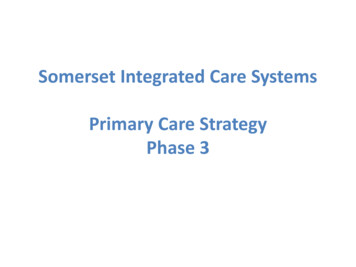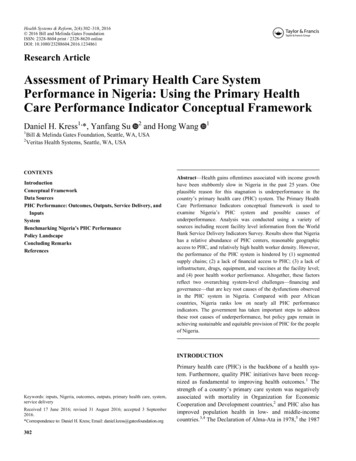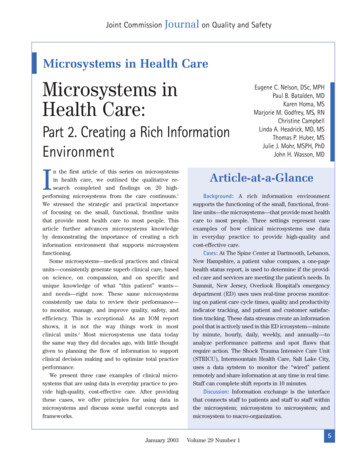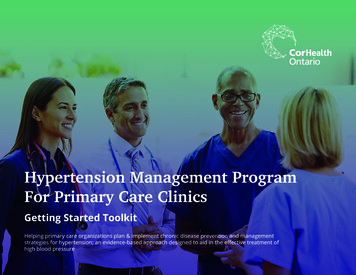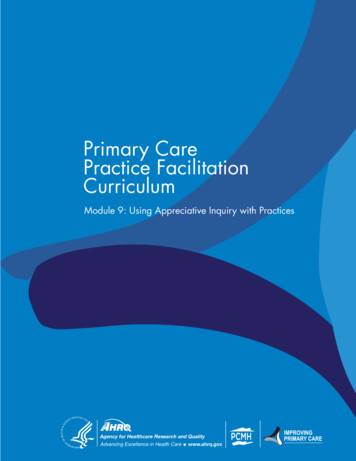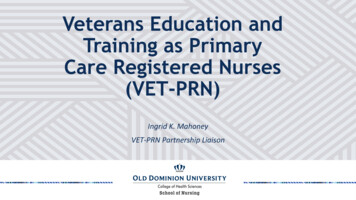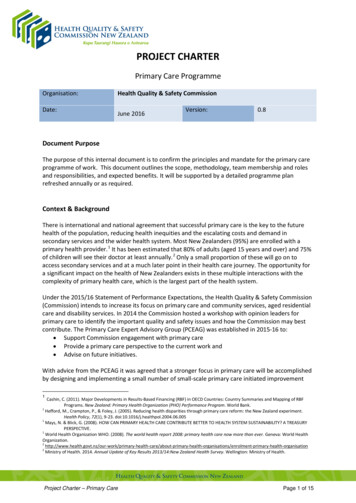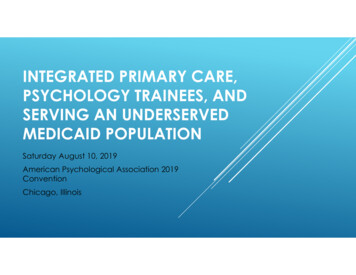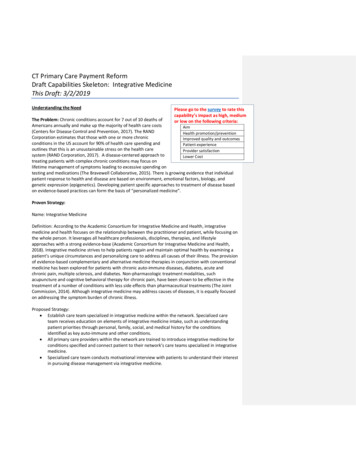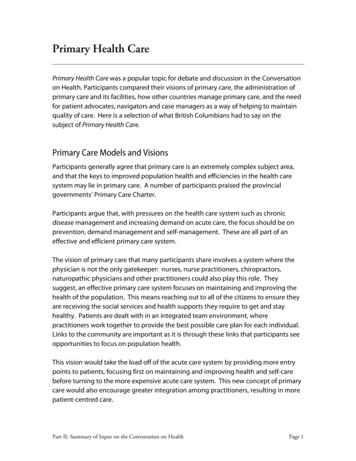
Transcription
Primary Health CarePrimary Health Care was a popular topic for debate and discussion in the Conversationon Health. Participants compared their visions of primary care, the administration ofprimary care and its facilities, how other countries manage primary care, and the needfor patient advocates, navigators and case managers as a way of helping to maintainquality of care. Here is a selection of what British Columbians had to say on thesubject of Primary Health Care.Primary Care Models and VisionsParticipants generally agree that primary care is an extremely complex subject area,and that the keys to improved population health and efficiencies in the health caresystem may lie in primary care. A number of participants praised the provincialgovernments’ Primary Care Charter.Participants argue that, with pressures on the health care system such as chronicdisease management and increasing demand on acute care, the focus should be onprevention, demand management and self-management. These are all part of aneffective and efficient primary care system.The vision of primary care that many participants share involves a system where thephysician is not the only gatekeeper: nurses, nurse practitioners, chiropractors,naturopathic physicians and other practitioners could also play this role. Theysuggest, an effective primary care system focuses on maintaining and improving thehealth of the population. This means reaching out to all of the citizens to ensure theyare receiving the social services and health supports they require to get and stayhealthy. Patients are dealt with in an integrated team environment, wherepractitioners work together to provide the best possible care plan for each individual.Links to the community are important as it is through these links that participants seeopportunities to focus on population health.This vision would take the load off of the acute care system by providing more entrypoints to patients, focusing first on maintaining and improving health and self-carebefore turning to the more expensive acute care system. This new concept of primarycare would also encourage greater integration among practitioners, resulting in morepatient-centred care.Part II: Summary of Input on the Conversation on HealthPage 1
Participants warn, however, that movement to a truly new system of primary care willrequire some major systemic adjustments, beginning with a new approach toremuneration and incentives for physicians and a new societal attitude towards healthand health care. This is a long-term change management process, which needs to bedesigned and managed effectively across government and communities with strongleadership in order to make it happen.Primary Health Care is a relatively neglected component of the health care system. Some of themost effective and lowest cost health systems are based on a 'primary care' foundation,supported by a thoughtful healthy public policy framework. This would represent a significantchange for BC, but offers a chance to move from a position of conservative, timid changewhere the inefficient, inequitable, costly private health care alternatives is allowed to creep inby default. This is not a time to be timid, but to learn from evidence and to invest wisely ratherthan react to headlines.– BC College of Family Physicians, SubmissionPrimary Care Administration and FacilitiesFacilities, funding models, and accountability structures were all explored indiscussions around new models for primary health. One of the key areas of debatewas whether primary care should be managed by health authorities. Someparticipants argued that moving primary care under the rubric of health authoritieswould provide a more holistic perspective on community health and the ability tobetter service the needs and demands of the population. Others argued that thisapproach would add bureaucratic inefficiencies and should be avoided.Community health clinics came up frequently as a way of encouraging a healthpromotion ethic and incorporating new practitioners into the medical system. Mostargue that these clinics should be publicly funded and easily accessible.Some participants argue that a new approach to primary care will also require a newapproach to funding models. There needs to be a way to compensate a physician foractivities that support community-based disease prevention and health promotion.They argue that without new funding models, introducing new entry-pointpractitioners into the system would be difficult. One suggested model is to createsalaried physicians who would serve a designated population. The physician would beresponsible for the health promotion and prevention needs of that population,measured based on population health outcomes, as well as individual healthoutcomes. Participants also advocated for the inclusion of certain primary care healthservices that are not currently funded through the Medical Services Plan, such aspreventive eye and dental exams and care.Part II: Summary of Input on the Conversation on HealthPage 2
International ModelsA number of participants had experience in or knowledge of primary health care inother jurisdictions, and many recommend a better understanding of these systems inorder to identify best practices, which could then be imported.One example put forward was from New Zealand, where primary care has gonethrough an overhaul over the past decade, culminating in the implementation of aprimary care strategy in 2003. New Zealand has moved to primary healthorganizations responsible for a defined population. Their focus is not just services,but preventive care and the reduction of health inequalities within their population.While expensive, New Zealand hopes that its investment will yield long-term savingsthrough health promotion and disease prevention.Patient Advocates and Navigators and Case ManagementParticipants describe the health care system as complex and challenging. Similarly,participants suggest the lack of continuing care affects the health of patients andcreates more pressure on the acute care system. Many believe that patient advocatesand navigators could help patients through the system dealing with both thiscomplexity and the continuity of care. This would be particularly true for BritishColumbians with different cultural backgrounds and language barriers.Many suggest a patient navigator could be very effective for older British Columbiansliving at home who may have a variety of practitioners and specialists as well as homecare services. A navigator could help them understand the care they receive, and howbest to take advantage of that care. An advocate could also push for different careand services when they feel it could improve patient outcomes and avoid expensiveacute care intervention. Participants also suggested creating a patient ombudsmanwho would receive and follow-up on patient complaints within the system.Navigators and advocates would help patients understand the system and the carethey are receiving. This would encourage and empower patients ultimately tomanage their own care.In pushing for an integrated approach to patient care, participants believe that thereneeds to be a new way to manage care, and they often suggested case managementas an effective approach. Through case management, all practitioners would be ableto understand every aspect of the patient care and work together to make it mostPart II: Summary of Input on the Conversation on HealthPage 3
effective for the patient. Similarly, participants advocate for improved dischargeplanning to coordinate services after a patient is released from hospital. Effectiveplanning, they argue, will avoid hospital re-admission and secondary health ailments.You need a better sense of a system of care into which a lot of senior’s care fits. What you needis a broad base of services, in an integrated and coordinated system of care, managed orfacilitated through good quality case management so that there is a champion for each personthat comes into the system of care. The components of the system see themselves as part ofthe system and therefore they also agree to conform to the general policies about accessibilityand how you get in, and what kind of care you get. What this allows you to do is provide muchmore seamless care for individuals if you have this kind of integrated system.- Focused Workshop Seniors and Aging, VancouverConclusionFor most participants, a new vision of primary care focused on the health ofpopulations. Integration of services and practitioners, continuity of care, and a focuson health promotion and disease prevention would all be supported by new facilitiesand funding mechanisms. Patient navigators and advocates, along with casemanagement and discharge planning would all work towards keeping people healthyand helping them manage their own care. Participants argue that investments inprimary care that work towards this vision will yield savings in the long-term.Part II: Summary of Input on the Conversation on HealthPage 4
Primary Health CareThis chapter includes the following topics:Primary Care Models and VisionsPrimary Care Administration and FacilitiesInternational ModelsPatient Advocates and Navigators and Case ManagementRelated Electronic Written SubmissionsHealth Human Resources ResponsesSubmitted by the BC College of Family PhysiciansPresentation to Conversation on HealthSubmitted by Vancouver Coastal Health AuthorityFamily Practice Recommendations for British Columbia’s Health Care SystemSubmitted by the Society of General Practitioners of British ColumbiaPhysicians Speak UpSubmitted by the British Columbia Medical AssociationAboriginal Conversation on HealthSubmitted by Vancouver Coastal Health AuthoritySunshine Coast Conversations on HealthSubmitted by the Women’s Health Advisory Network, the Sunshine Coast Hospital and HealthCare Auxiliary and the Seniors Network Advisory GroupHEU Submission to BC’s Conversation on HealthSubmitted by the Hospital Employees’ UnionSubmission to the Conversation on HealthSubmitted by the BC Nurses’ UnionSubmission to the Conversation on HealthSubmitted by the BC Cancer AgencyRelated ChaptersMany of the topics discussed by participants in the Conversation on Health overlap;additional feedback related to this theme may be found in other chapters including:Access; Scope of Practice; Health Care Models and Collaboration in the System.Part II: Summary of Input on the Conversation on HealthPage 1
Primary Care Models and VisionsComments and ConcernsSystem Design and VisionEntry-PointsCitizen- and Patient-Centred CareChange Management Comments on system design and vision: We need to define what success looks like from a medical system perspective(chronic and acute care), from a socio-economic perspective, and from all pointsof entry. Economic arguments are critical. The gatekeeper cannot be restricted todoctors. The business model equates to short-term thinking as opposed to the primaryhealth care mode, which is about long-term thinking. I read the Primary Health Care Charter in the last couple of days and I am amazedat what is there and I would really encourage everybody to read it. It is a reallygood overview of where primary care should be going in the province. Primary care is that continuum from prevention of disease through healthpromotion, healthy lifestyles, and also includes aggressive best practicesmanagement of chronic diseases. Primary health care is complex, belying its secondary position in the health caresystem. Efficiency, safety and effectiveness warrant engagement of a range ofskills; reliance on family physicians as the sole clinical resource is outdated. Primary Health Care is a relatively neglected component of the health care system.Some of the most effective and lowest cost health systems are based on a primarycare foundation, supported by a thoughtful healthy public policy framework. Thiswould represent a significant change for British Columbia, but offers a chance tomove from a position of conservative, timid change where the inefficient,inequitable, and costly private health care alternatives are allowed to creep in bydefault. This is not a time to be timid, but to learn from evidence and to investwisely rather than react to headlines. People living with heart disease, asthma, diabetes, depression and other chronicillnesses do much better when they have access to primary health services thatinclude on-going support, education, nursing and outreach services along withhealth promotion strategies. Many of these services are funded outside doctors'Part II: Summary of Input on the Conversation on HealthPage 2
negotiated fee-for-service agreements. They can be provided by nurses,nutritionists, mental health outreach and community health workers. For the last ten years I have watched family practitioners and family practice justheading downhill and it looked like there was no future at all for family practice.And now that has been reversed with things like the Primary Healthcare Charter.It is really encouraging. When I saw that Primary Healthcare Charter originally, Iput it aside because I wondered what the point was, and thought it was just moregovernment stuff that they have in committees that I sit on. From my point ofview, if there is no economic reason for family doctors to change, why would theychange when they are already running as fast as they can and making about 40per cent of what specialists do. There is a significant body of research out there demonstrating that a robustsystem of primary health care improves health outcomes and quality of life andreduces the burden on the acute care system, yet we have a growing shortage ofprimary health care providers in British Columbia. We need to do more to encourage family doctors back into the hospital. Foreconomic reasons, they have fled the hospital. There are studies to show thathospitalists can get people out of hospital quicker than family doctors normally.But if the family doctor is involved they are discharged quicker still. So I think weneed to have both the family doctor and the hospitalist involved in the hospital. The key piece of the primary care vision is to have coordination, collaboration, anda team facilitated by appropriate tools, like the electronic record, so that theprimary caregivers have the time and space to coordinate their teams,communicate with each other and interact relationally with the people they areproviding care for. It is that connection and relationship that helps us really dealwith those lifestyle issues that were mentioned and with real preventive care tokeep people out of the acute care system when they do not need to be there, andto provide efficient and effective care. Right now we have acute care as the foundation of the system and everything elseis feeding into acute, and that is why patients that are unattached are going to theEmergency Departments. If we flipped it and said no, primary care is thefoundation of the health care system and we are building the system to supportprimary care, then you ask how you provide access for these unattached patients.What are the social determinants that we need to look at? What are the socialbehaviours that we need to support? So there are huge significant questions inorder to start challenging the design of the health care system. Primary health care covers many themes. The first theme is the capability of thepeople. The second theme is ecological, because health involves communities,Part II: Summary of Input on the Conversation on HealthPage 3
volunteer sectors and non-profits. The third theme was the systems, like theprimary, secondary and tertiary systems and their integration. The fourth theme ishealthy public policy. A primary health care model starts with the person in the centre and therelationship that that person has with the health care system and the players inthe health care system. The circle around the person is the primary health caresystem and that that primary health care system is based on human needs, boththe human needs of the patient and the human needs of the providers. Thepentagram around the outside represents the players in the health system andtheir interaction, integration and relationship is really important. So the policymakers, the professionals and health care workers, the academics, the community,volunteers, non-government organizations and so on, and then health managers.There are relationships that need to be built between all of those different players.This is the lens that we would use to look at finding the solutions to some of thechallenges we have in the health care system. The clinical practice approach needs to be based on health planning: planningpeople's health and being proactive with call backs and care of the client. I prefer community-based and multi-disciplinary approaches to what I call thedoc-in-a-box model of primary health care, which is just expanded overgrownfamily practices employing numerous doctors. The literature reviews do showthat some chronic diseases, for example, have better outcomes when managed bynurses as opposed to physicians. So, I think we need to go where the evidencetakes us. Current directions in primary health care talk about patients without mention offamilies and coordinating services. Health care should focus more on keeping people well, including, nutrition,getting additives out of food, chemicals out of the environment, and people off ofdrugs. We need better primary health care focused on preventative medicine. Educationon root causes of poor health can improve the overall delivery of health careservices. Primary care has to be linked to social determinants and tertiary care to create anintegrated accessible system. You want to have good linkages. You want to be able to support the doctors andother practitioners.Part II: Summary of Input on the Conversation on HealthPage 4
The quality of care is far superior with the classic example of the family doctorwho knows your medical history and is willing to engage in productive dialoguealong with a proper examination. Right now the two systems are working against each other. This is the criticaldivide and health authorities and Ministry of Health are strategically pushing this. Physiotherapists and doctors can give opposite advice. A primary health careteam could talk together and have patient conferences to develop a commonapproach to the particular ongoing problems of an individual. There are some examples now where health authorities have set up primary careclinics. Our health authority set up one in Ladysmith when we shut down thehospital. There is a population-based funding clinic called Spectrum Health and they havefive doctors in there. They divided up their work and took leadership roles in avariety of ways and they were very innovative. They did not have to report to thehealth authority. They went out and got funding from other sources to bring insome other professions to work in the team. They are far more flexible and lesslimited by the bureaucracy. Primary prevention has proven that it will save you money in the long run. Sincewe have attacked this problem from an acute care model for so long, and it is notgetting anywhere, let us change our focus. Maybe we set up clinics. Maybe weset up something even within the acute care system. We have so many hospitalsthat probably have space that you could put the clinic in the hospital. So you arestill gong to the hospital, but you are seeing a different practitioner there in adifferent environment. We have already made a major shift in how we deal withambulatory care. We have something called Care North. It brings nurses and physicians together tohold group appointments with patients. Patients will come in with other patientsand have access to a variety of professionals. The Ontario Health Services Restructuring Commission produced the best overallsta
Part II: Summary of Input on the Conversation on Health Page 1 Primary Health Care Primary Health Care was a popular topic for debate and discussion in the Conversation on Health. Participants compared their visions of primary care, the administration ofFile Size: 342KBPage Count: 36People also search forprimary health care pptprimary health system pdf ra uru huintroduction to healthcarehuman design inner visionuniversity of kentucky nurse practitionermurray state university nursing program
